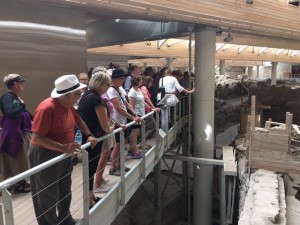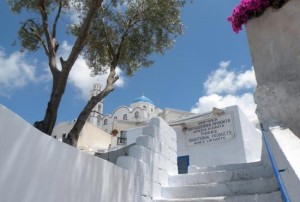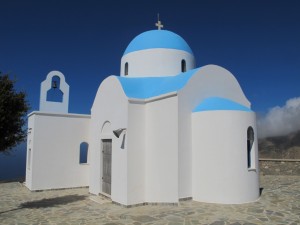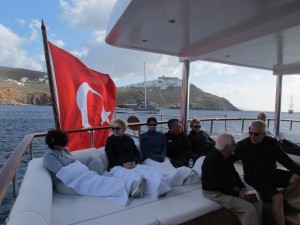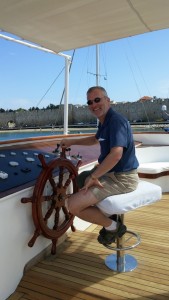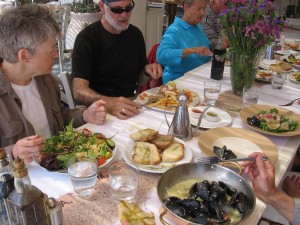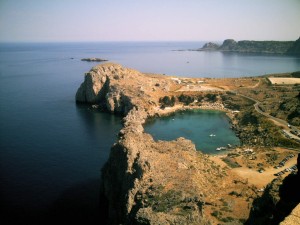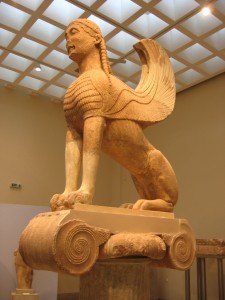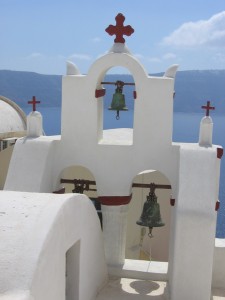 On Friday (Good Friday) we left our gulets for the last time. We bid farewell to the cheerful and hard-working crew and met our bus in the new port. We were transferred up the zig-zagging road to our luxury resort hotel, the Volcano View. Like everything in Santorini, our new home is greatly influenced by the unique geology. The hotel boasts that uniquely Santorinian architecture of descending rooms that are partially built IN-to and partially built ON-to the bedrock of the caldera. Semi-cavelike, the rooms are all individually shaped, finished, and furnished.
On Friday (Good Friday) we left our gulets for the last time. We bid farewell to the cheerful and hard-working crew and met our bus in the new port. We were transferred up the zig-zagging road to our luxury resort hotel, the Volcano View. Like everything in Santorini, our new home is greatly influenced by the unique geology. The hotel boasts that uniquely Santorinian architecture of descending rooms that are partially built IN-to and partially built ON-to the bedrock of the caldera. Semi-cavelike, the rooms are all individually shaped, finished, and furnished.  Maia’s and my room had a huge bathroom cut back into the hillside with a mini-amphitheater like shower niche. It was a cross between the Flintstones and the Hollywood Bowl. So unique. So fun. We had our pick of 3 or 4 pools (I never did get an accurate count) and multiple gazebos, terraces, and balconies for enjoying the sunsets.
Maia’s and my room had a huge bathroom cut back into the hillside with a mini-amphitheater like shower niche. It was a cross between the Flintstones and the Hollywood Bowl. So unique. So fun. We had our pick of 3 or 4 pools (I never did get an accurate count) and multiple gazebos, terraces, and balconies for enjoying the sunsets.
But we didn’t tarry long. This was our biggest sightseeing day. We started with charming Megalochora – Santorini’s big-little village. Big because the name means “Great Village”, little because, well, its tiny. Our impossibly charming guide Eugenia (yes, impossible is the best description of EVEN the guides in these islands) walked us through the village explaining the traditional architecture,
weaving in local tales, and pointing out the pistachio and almond trees as we went. Then we took a lunch break at Perissa, the islands sweeping arc of black sand beach. We reboarded our bus and headed south to Akrotiri, the Minoan era archaeological site. A quick overview of the island's signature red sand beach afforded lots of photo snapping prefaced our visit. Once again, effervescent Eugenia breathed life into our Akrotiri visit. She helped understand this ancient culture and the circumstances of their Pompeii-like demise. Our penultimate stop was Oia – the crème de la crème.
On the world’s most beautiful island, this is the most beautiful town. Tumbling down the hillside like Fira, Oia has enlisted the use of many more pastel colors in its town palette and it is crowned by a ruined fort. Moreoever, the community here is more artistic and less commercial (except the prices!). Lots of boutique shopping, original art and crafts, and plenty of view spots for sunset.
The day had turned blustery so it was a little easier to tear ourselves away from this Santorini jewel and head for our climactic Holy Friday stop. Easter is the biggest holiday on the Greek calendar and Santorini is a famous place for its festivities. Topping that list is the Epitaph procession of the island’s highest village, Pyrgos. The locals use canisters filled with oil and straw to line the meandering path that winds through the village to Agios the village church at the top.
At the appointed hour, the priest brings the Epitaph out of the church for its ceremonial descent through the village. At that moment the canisters are lit and the whole hillside becomes a flickering blaze of living lights. We arrived as the crowds were gathering. Eugenia led us up the tiny alleys to the church and the kastro ruins above it. Having seen the layout, she explained the procession and its significance. Then we returned to the lower edge of town where she had booked us into a wonderful restaurant with an unobstructed view of the hill-top town. We were warm, dry, comfy, and enjoying some great Santorini wine when the village crown ignited into dancing light. What a spectacle!








